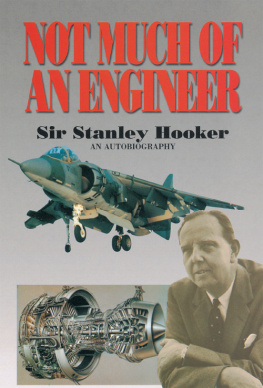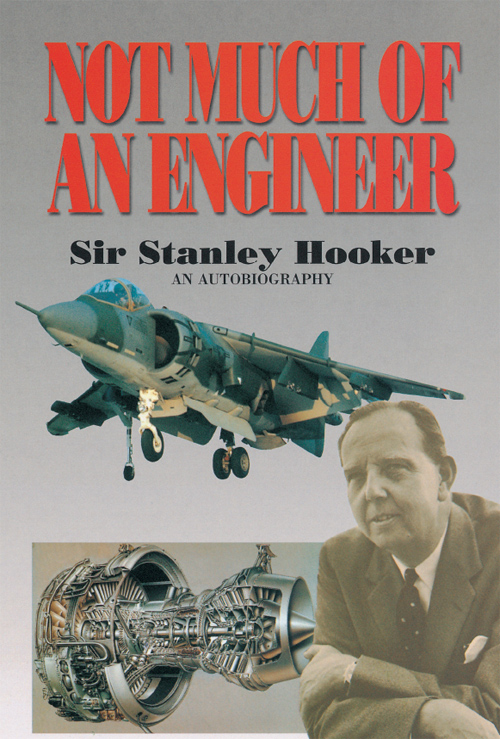Not much of
an En g ineer
an autobiography
Sir Stanley Hooker
assisted by
Bill Gunston
Airlife
England
Contents
This is a love story between aircraft
engines and two people.
Kate Hooker
Foreword
by The Lord Keith of Castleacre
Most laymen regard higher mathematics as a dull subject and consequently suspect that those who practise it must be somewhat sombre and live in a rarefied atmosphere.
Stanley Hookers life story and the way he has written it clearly disprove this view.
Stanley first came into my life when in October, 1972, I went to Rolls-Royce as Chairman of a company recently rescued from bankruptcy, but still proudly possessing one of the greatest of names. He rapidly became my guide, philosopher and friend. He held my hand, technically, throughout the seven years I was with the company and I shall always be deeply grateful to him.
This brilliant mathematician, who won almost every available scholarship and academic prize, is possessed of a warm and loveable character. He has a capacity for making enduring friendships with all types, kinds and nationalities. A truly modest man, he is generous to a degree. He was the first to give credit to others when things went right; equally the first to assume the blame when things went wrong. As the reader will discover, he also has a ready wit and an excellent sense of humour.
Almost by accident, he became one of the worlds most brilliant engineers. His clear and precise mind was combined with the engineering equivalent of green fingers when it came to solving abstruse problems, as he so clearly demonstrated when he led the technical rescue work on the RB211, thereby saving it for the nation following the Rolls-Royce bankruptcy.
If asked to pinpoint his greatest contribution to the nation, I suppose one would start with his work as a supersonic airflow expert, analysing superchargers, thereby giving them improved and more predictable performance. This resulted in the Merlin engine keeping ahead of the Germans, with inestimable benefit to the R.A.F., throughout the war.
Stanley changed the face of the aero-engine business when he introduced Lord Hives to Sir Frank Whittle and persuaded the former that he should take the gas turbine seriously. He then went on to father the design of the Nene engine which was to become the forerunner of the modern gas turbine and which was licensed to the Americans and, foolishly, sold by the Government of the day, to the Russians. Incidentally, Meteors powered by the Rolls-Royce Welland engine built at Barnoldswick under Stanleys guidance were first used in action to chase and destroy flying bombs in August 1944.
He was also a supporter and promoter of vectored thrust and played a major part in the development of the Pegasus engine. This enabled Sydney Camm to design the Harrier which demonstrated its outstanding capabilities in the Falklands war.
Stanley has that rare and invaluable facility of making complicated technical matters understandable to the layman. He is the master of the blackboard and chalk and is able to give even people like myself a reasonably clear idea of how the engine works.
This book records how he left Derby to go to Bristol in 1948; how he returned temporarily in 1967; and how he finally became director of engineering at Rolls-Royce in 1971.
I have often wondered how different the course of Rolls-Royce and indeed British high technology engineering might have been if those two outstanding but determined men Lord Hives and Stanley Hooker had been a little more flexible and a little less precipitate in September 1948 and had Stanley not left Derby to go to Bristol.
I hope that everyone who reads this book will enjoy it as much as I have done.
Keith of Castleacre
March 1984
Chapter 1
The Professional Student
It was a damp, cold day in January 1938 when I garaged my car at the junction with the Osmaston Road and began to walk up Nightingale Road towards the great Rolls-Royce works in Derby.
The dreariness of the street, with its terrace of redbrick workers houses on the left, interspersed with the odd conversion to a general grocers or tobacconist, and on the right a small open lot used as a works car park, matched the foreboding in my mind. Not a soul was in sight, nor was there any noise, because the workshops were set back from the road behind the front facade of offices.
With each step I took, my heart sank further. Why had I left my comfortable and interesting job in the Scientific Research Department of the Admiralty? And what was I going to do in the formidable Rolls-Royce company, which represented the very pinnacle of engineering excellence?
I was no engineer. I had been trained in Applied Mathematics, so how could I hope to compete with, or even to help, the semi-Godlike engineers with which, I was convinced, Rolls-Royce must be stocked doubtless trained by the legendary Sir Henry Royce himself?
The apprehension grew as I approached the main entrance on my right. It stood back a few yards from the pavement, with an oval drive in and out in front. At the door stood a very smart uniformed commissionaire. I approached him with caution.
Yes, sir, you will find Mr Elliotts office in the next block. Take the next gate on the right, and then the entrance to the Engineering Offices is on your left.
I found my way easily enough, and stumbled along the corridor until I reached the office marked A. G. ELLIOTT, Chief Engineer. I knocked and was told to enter. It was not a large office, and very sparsely furnished. Mr Elliott sat at his desk, back to the windows and facing the door. In the further corner sat his personal assistant, A. Livesey.
Elliott clearly had not the foggiest idea who I was, and had forgotten that he was to interview me. He spoke very quietly and enquired about my business. I explained that I was the new man joining the firm, by name Hooker. He smiled as the memory came back and said, Of course, welcome to Rolls-Royce. We have prepared an office for you, and Mr Livesey will show you to it.
The interview was over that quickly, and it was not at all what I had expected. Livesey led me around the corridor, and at a junction he opened a door, and said This is your office, cheerio. The walls were painted metal for the first four feet from the floor, and frosted glass above. It was about eight feet square and contained a desk, a chair, an empty bookcase and a telephone, and nothing more. I sank bewildered into the hard chair and gazed at the nothingness of the wall.
All around me there was a hive of industry. I could hear telephones ringing, the clacking of typewriters, and the hum of conversation. Mostly the offices were much larger open spaces with similar dividing walls, but housing groups of men working with intense concentration. A very large area was clearly devoted to design, and full of towering drawing-boards.
Later I learned that rumour and curiosity was rife about the new so-called mathematical whizz kid who had been granted the rare privilege of a private office. At the time I was just ignored, completely.
And so the day wore slowly on. I had anticipated that I would have been put into the charge of some awe-inspiring engineer, who would have allocated me some simple tasks while instructing me in the mysteries of the super aero engines that Rolls-Royce was designing and producing. But it was not so. I, who had never seen an aero engine at close range, and who only had a schoolboys knowledge of its inside, did not even know the names of the engines Rolls-Royce was producing.










